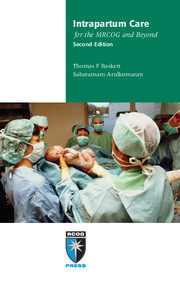Book contents
- Frontmatter
- Contents
- Preface
- Abbreviations
- 1 Improving intrapartum care
- 2 First stage of labour
- 3 Second stage of labour
- 4 Fetal surveillance in labour
- 5 Third stage of labour
- 6 Lower genital tract trauma
- 7 Induction of labour
- 8 Preterm labour and prelabour rupture of membranes
- 9 Assisted vaginal delivery
- 10 Shoulder dystocia
- 11 Breech vaginal delivery
- 12 Twin and triplet delivery
- 13 Caesarean section
- 14 Vaginal birth after caesarean section
- 15 Uterine rupture
- 16 Emergency obstetric hysterectomy
- 17 Cord prolapse
- 18 Antepartum haemorrhage
- 19 Postpartum haemorrhage
- 20 Acute uterine inversion
- 21 Amniotic fluid embolism
- 22 Disseminated intravascular coagulation
- 23 Acute tocolysis
- 24 Severe pre-eclampsia and eclampsia
- 25 Neonatal resuscitation
- 26 Perinatal loss: management of late fetal death and stillbirth
- Index
3 - Second stage of labour
Published online by Cambridge University Press: 05 July 2014
- Frontmatter
- Contents
- Preface
- Abbreviations
- 1 Improving intrapartum care
- 2 First stage of labour
- 3 Second stage of labour
- 4 Fetal surveillance in labour
- 5 Third stage of labour
- 6 Lower genital tract trauma
- 7 Induction of labour
- 8 Preterm labour and prelabour rupture of membranes
- 9 Assisted vaginal delivery
- 10 Shoulder dystocia
- 11 Breech vaginal delivery
- 12 Twin and triplet delivery
- 13 Caesarean section
- 14 Vaginal birth after caesarean section
- 15 Uterine rupture
- 16 Emergency obstetric hysterectomy
- 17 Cord prolapse
- 18 Antepartum haemorrhage
- 19 Postpartum haemorrhage
- 20 Acute uterine inversion
- 21 Amniotic fluid embolism
- 22 Disseminated intravascular coagulation
- 23 Acute tocolysis
- 24 Severe pre-eclampsia and eclampsia
- 25 Neonatal resuscitation
- 26 Perinatal loss: management of late fetal death and stillbirth
- Index
Summary
The second stage of labour lasts from full dilatation of the cervix to delivery of the infant. It is the stage when the fetus is most vulnerable, with hypoxia and trauma being the main threats. This was highlighted in the 4th Annual Report of the Confidential Inquiry into Stillbirths and Deaths in Infancy, emphasising the clinical and medico-legal aspects of the second stage of labour.
The second stage has two phases: the first, passive, phase occurs from full dilatation of the cervix until the head descends to the pelvic floor and the second, active, phase starts when bearing-down efforts of the mother begin. Thus, the terms passive and active refer tomaternal effort. The two phases may also be referred to as the pelvic and perineal phases. In the multiparous woman the passive phase can be very brief and last only a few minutes. However, in the nulliparous woman the head is often at the level of the ischial spines when full dilatation is reached and more time and uterine action is required to cause descent of the presenting part to the pelvic floor. In this and other aspects of care during labour, it is important to differentiate between the performance of the nulliparous and multiparous woman.
Utero–fetal–pelvic relationships
The relationship between maternal effort, uterine action, the fetal presenting part and the pelvis is dynamic rather than a mechanical set of measurements. The following factors require evaluation and, as in the first stage of labour, can still be usefully considered under the old classification of the three Ps (see box overleaf).
- Type
- Chapter
- Information
- Intrapartum Care for the MRCOG and Beyond , pp. 19 - 28Publisher: Cambridge University PressPrint publication year: 2011



